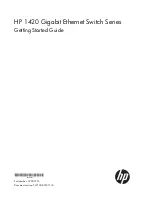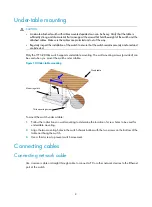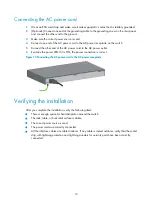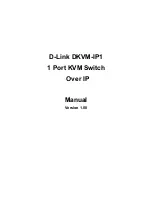
2
Examining the installation site
The switches must be used indoors. You can mount your switch in a rack, on a horizontal surface, on a
wall, or under a table. Make sure the following requirements are met:
•
A minimum of 5 cm (1.97 in) of clearance is reserved at the air inlet and outlet vents for ventilation.
•
The rack has a good ventilation system and the air inlet and outlet vents are not blocked when the
switch is mounted under a table or on a horizontal surface.
•
The rack, table, or horizontal surface is sturdy enough to support the switch and its accessories.
•
The rack is reliably grounded.
To ensure correct operation and long service life of your switch, install it in an environment that meets the
requirements described in the following subsections.
Temperature/humidity
Maintain temperature and humidity in the equipment room as described in "
•
Lasting high relative humidity can cause poor insulation, electricity creepage, mechanical property
change of materials, and metal corrosion.
•
Lasting low relative humidity can cause washer contraction and ESD and cause problems including
loose mounting screws and circuit failure.
•
High temperature can accelerate the aging of insulation materials and significantly lower the
reliability and lifespan of the switch.
Cleanliness
Dust buildup on the chassis might result in electrostatic adsorption, which causes poor contact of metal
components and contact points, especially when indoor relative humidity is low. In the worst case,
electrostatic adsorption can cause communication failure.
Table 2
Dust concentration limit in the equipment room
Substance
Concentration limit (particles/m³)
Dust
≤
3 x 10
4
(no visible dust on the tabletop over three days)
NOTE:
Dust diameter
≥
5
μ
m
The equipment room must also meet strict limits on salts, acids, and sulfides to eliminate corrosion and
premature aging of components, as shown in
.
Table 3
Harmful gas limits in the equipment room
Gas
Maximum concentration (mg/m
3
)
SO
2
0.2
H
2
S 0.006
NH
3
0.05






































